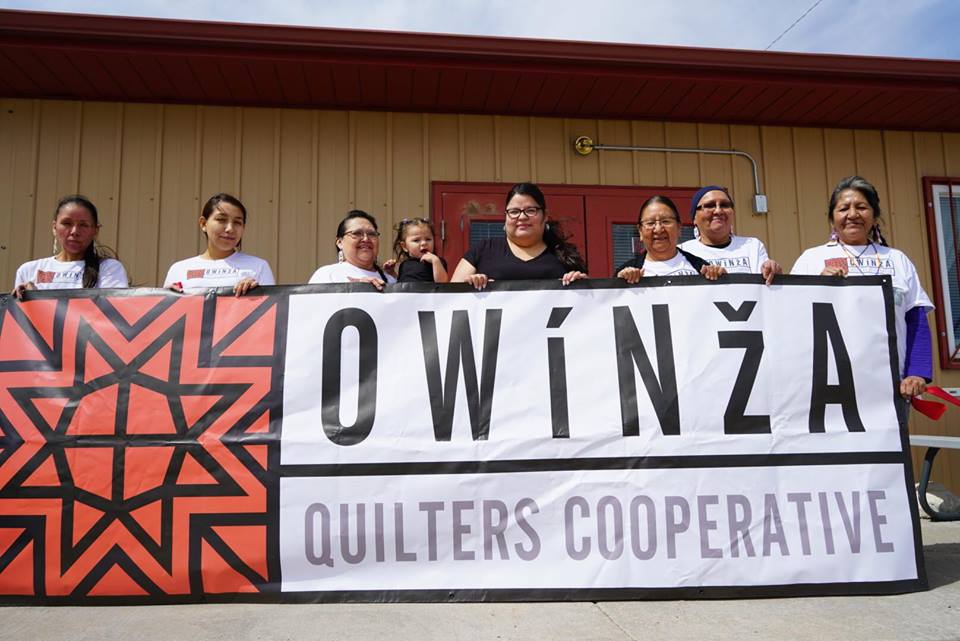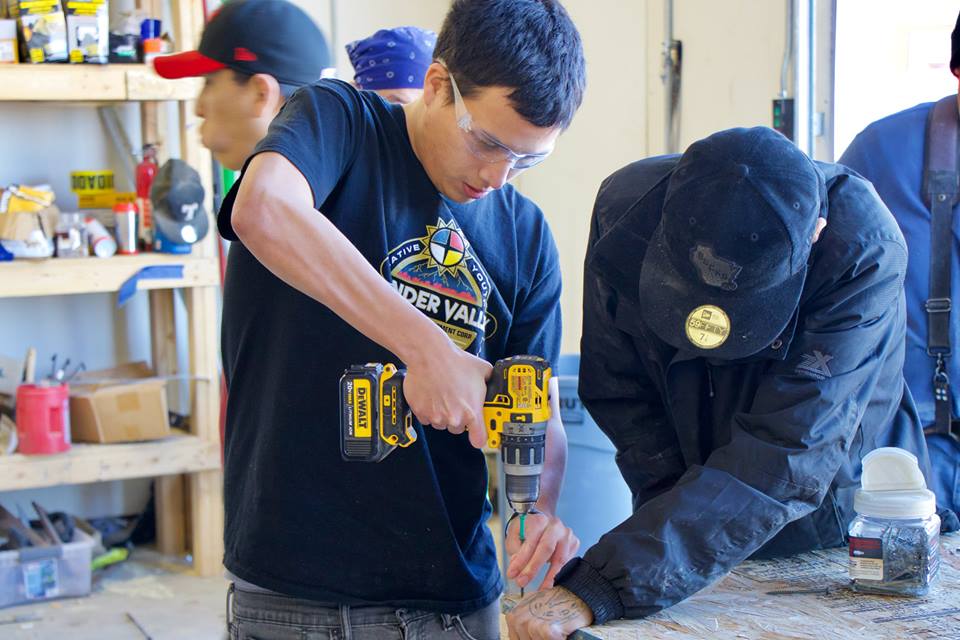
Thunder Valley Community Development Corporation (TVCDC) is a Lakota led non-profit based in the Thunder Valley community of the Porcupine District on the Pine Ridge Indian Reservation, which celebrated its 10 year anniversary in 2017. For the last five years, TVCDC has participated in and co-created the Learning/Action Lab for Community Wealth Building, alongside The Democracy Collaborative, the Northwest Area Foundation and four other Native American community-based organizations, to develop and work through strategies that build and root wealth locally for the benefit of their community.
Recently, TVCDC unveiled its first two worker-owned businesses launched as part of its initiative to build community wealth through the development of new social enterprises that will be owned and run by local people. With staggering 80% unemployment on the Reservation, where 48% of residents of live below the poverty line, the Owíŋža Quilters Cooperative and Thikáǧa Construction Company are breaking the cycle of poverty rooted in the historic dispossession of Native lands and livelihoods by creating local jobs for the Lakota people that keep the wealth on the Pine Ridge Reservation.

The Owíŋža Quilters Cooperative is an entirely women- and member-owned co-op that allows quilt-makers to partner to access a common customer base and increase their skill levels through collaboration instead of competing against each other. TVCDC is providing financial support, resources, and training in business development to support members in their work and forge a stronger community of Native cultural producers. The co-op membership reflects the Lakota value of intergenerational sustainability that will enable long-term economic development and community wealth building on the Pine Ridge Reservation. The mix of generations, which currently includes six elders and two women in their 20s, sets up a structure for future generations to engage with traditions and Native values in a tangible way. The quilt-makers plan to grow their business capacity to meet national and international demand. In the meantime, as of April 2018, quilts can be purchased at the Owíŋža storefront on the Pine Ridge Reservation.
The second social enterprise, also launched in the spring of 2018, is aimed at helping create solutions for Pine Ridge’s dire crisis around housing. There is a documented shortage of affordable housing on the reservation and the existing housing stock is often in substandard condition. The median home value on the reservation is just one-fifth of the US average, with 70% of all housing on the reservation being HUD housing or trailer homes, limiting residents’ ability to build equity. Substandard conditions also affect health: an EPA report documented mold in 75% of housing units. Combined with rapid population growth on the reservation—census figures show nearly three times the growth rate of South Dakota—the limited availability of quality affordable housing options is a major problem in the face of an existing and growing demand for housing.
Thikáǧa Construction, a employee-owned construction company, was launched in April 2018 to address this issue of unmet housing needs in the Lakota community. The company builds homes that are adaptable to climate change, resilient enough to be passed on to future generations, and are reflective of traditional Lakota designs. It will start off by building at least 13 homes as part of TVCDC’s new community development project, the Regenerative Community (more on that below). TVCDC currently owns 51 percent of the company and the company’s employees own the remainder. Over the course of time, employees will own 75 percent of the company.

Creating local employment opportunities is important, but so is developing the capacity and skills in the local workforce so they are able to take advantage of these opportunities and succeed. TVCDC’s Workforce Development Program is a 10-month opportunity for Lakota youth ages 18-26 to gain knowledge and Native-based job readiness training in sustainable construction, while continuing their education. The program requires all participants to advance beyond their current level of education upon entering the program, viewing further education attainment as integral to participants’ greater long-term career success. Moreover, the program also emphasizes social-emotional development to address the issues that participants often face outside the workplace. By recognizing participants as whole people, the workplace program strives to create future leaders in the community. By developing the capacity and skills of people locally while also creating jobs, TVCDC is working to combat the current statistic whereby 60% of those who live on the reservation work somewhere else and 56% travel more than 50 miles to work. The initial 10-12 employees of Thikáǧa Construction will be graduates of the Workforce Development Program.
For TVCDC, these social enterprise and workforce development initiatives are part of a broader vision for transformative change. TVCDC was originally started as a grassroots effort by young people to rebuild and revitalize the Lakota community from the ground up. After a series of community conversations and planning efforts, the “Regenerative Community Development” project was launched to address the Lakota Nation’s needs for self-sufficiency, economic self-determination, and ecological resilience. This groundbreaking project is envisioned to be a living laboratory that explores new ways of living and replicable pathways that will serve as a national model to alleviate poverty and build sustainable communities. While upholding the traditional Lakota cultural wisdom, this ambitious project will create jobs, build assets, increase stability, preserve the environment, and improve the health of the community.
In addition to homes that can be purchase or rented with little-to-no utilities cost (thanks to sustainable design incorporating high energy efficiency native materials and renewable energy sources), the 34-acre community development will feature: a cultural center, youth spaces, a workforce development training center, a business incubator, a daycare and fitness center, and other facilities needed to create opportunity for the Oglala Lakota Nation. Neither tradition nor innovation are sacrificed for the other in the development of the Regenerative Community. For instance, referencing the sacred geometry of the teepee circles that the Lakota ancestors traditionally lived in, the site plan for the homes incorporates a small group of 7 homes arranged around a circle of shared space to create a “pocket neighborhood.” Currently, Phase One of the Regenerative Community is underway, which is a three-year process that heavily focuses on housing development. Infrastructure, such as roads, water, and sewer, are being built in this first phase, and will also expand existing projects, including the Workforce Development Training Center. Homes, as well as an apartment complex/bunkhouse for TVCDC staff, interns, and volunteers who mostly commute long distances, will be built in the years following. Ultimately, the project will help achieve the larger goal of overcoming intergenerational poverty by creating systemic change through action and sustainable development.

The movement for innovative, homegrown Native solutions is quickly spreading. Nick Tilsen, the founding executive director of TVCDC, recently announced that he will step down from his current staff position in order to focus on a new initiative, the NDN Collective. Growing out of requests from other indigenous communities to create their own community development organizations, the collective comprises of “indigenous activists, organizers, tribal leaders, social entrepreneurs, artists, educators, innovators and changemakers who are working to build the collective power of indigenous peoples, communities and Nations.” The collective and its subsidiaries and projects are being incubated by Thunder Valley CDC.
The Owíŋža Quilting Cooperative and Thikáǧa Construction Company are examples of the change that happens through action, where the Lakota people are taking responsibility and ownership for their own future. As Andrew Iron Shell puts it: “The beauty that people romanticize about Lakota country, that’s real. But look under that, because the reason why that’s real, is the resilient people.”
--
Thunder Valley CDC is a participant in The Learning/Action Lab for Community Wealth Building, an initiative of The Democracy Collaborative and the Northwest Area Foundation, that focuses on fostering and sustaining comprehensive community economic development in Native American communities.
Photos from Thunder Valley CDC's Facebook Page.